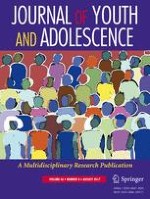03-01-2017 | Empirical Research
Examining Socio-Cultural and Neighborhood Factors Associated with Trajectories of Mexican-Origin Mothers’ Education-Related Involvement
Gepubliceerd in: Journal of Youth and Adolescence | Uitgave 8/2017
Log in om toegang te krijgenAbstract
Parental involvement in education is an important determinant of youth’s academic success. Yet, there is limited knowledge on how Latino parents’ education-related involvement changes over time. Using data from a longitudinal study of 674 Mexican-origin families (mother-adolescent dyad; M
age
of child at Wave 1=10.4, SD = 0.60), we examined trajectories of parental involvement from 5th to 11th grade and the effects of socio-cultural (e.g., family SES and acculturation) and contextual (e.g., neighborhood) factors on these trajectories. Results showed that mothers reduced two aspects of the educational involvement: home-based involvement and academic aspirations, but increased on a third aspect of involvement, resource seeking. Furthermore, family SES, acculturation, and neighborhood context were differentially associated with mothers’ involvement at 5th grade and predicted changes in involvement across elementary and high school.
